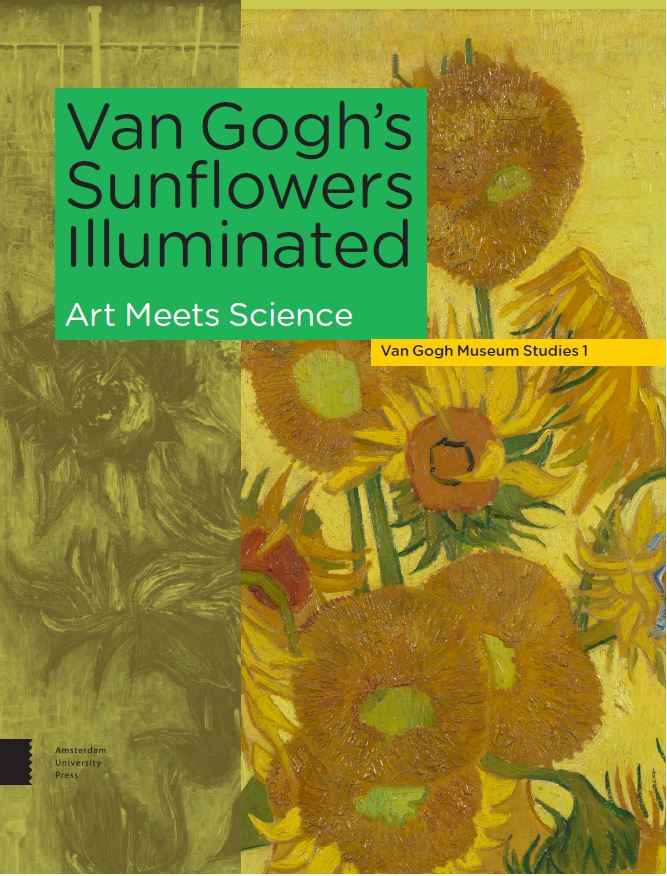
In 2019, the Van Gogh Museum in Amsterdam showed the exhibition Van Gogh and the Sunflowers. A Masterpiece Examined and published a catalogue with the same title. The museum showed the famous painting of a vase with sunflowers (book cover) together with 22 additional, sunflower-related works by Vincent Van Gogh.
The artist painted Sunflowers in 1888 and 1889 in Arles, a town in southern France. In total, Vincent Van Gogh created eleven still lifes featuring sunflowers, including five canvases featuring large sunflower bouquets in vases.
In recent years, a team of over 30 international scientists, conservators and art historians employing the most advanced technological tools studied the version in the Van Gogh Museum in Amsterdam. The goal was to identify the materials Van Gogh used, how he painted the composition, what condition the work is in, and what can be done to preserve it as effectively as possible for the future.
Ella Hendriks, Professor of Conservation and Restoration of Moveable Cultural Heritage at the University of Amsterdam, presents the results of that complex, interdisciplinary research in this book (Amazon.com, Amazon.co.uk, Amazon.fr, Amazon.de). She discusses Van Gogh’s methods and materials, as well as earlier restorations performed on Sunflowers and the discoloration that has occurred over time. Nienke Bakker, the Van Gogh Museum’s Senior Curator, explores the genesis of the painting and the special significance that the sunflower held for Van Gogh.
This book presents the key research findings in an accessible way for a broad public, while situating the Amsterdam museum version of Sunflowers in the context of the flower still lifes of the period in general and of Van Gogh’s oeuvre in particular. The technical and scientific research itself has been published in Van Gogh’s Sunflowers Illuminated: Art Meets Science, the first volume in the Van Gogh Museum Studies series ( Amazon.com, Amazon.co.uk, Amazon.fr, Amazon.de).
Vincent Van Gogh’s preference for the sunflower motif was closely bound to his friendship and rivalry with fellow artist Paul Gauguin, with whom he shared a studio in Arles. Van Gogh himself considered his sunflower paintings among his best works, and they were featured in exhibitions while he was alive. They soon came to be viewed as icons of art history.
As mentioned above, Sunflowers in the Van Gogh Museum dates from 1889, shortly after the painter’s hospitalization and the disastrous end to his collaboration with Paul Gauguin. It was Gauguin who first acknowledged the power and originality of the Sunflowers paintings, praising the 1888 canvas with the yellow background (now in the National Gallery, London) as ‘a perfect page of an essential “Vincent” style’. When he asked if he could have the painting, Van Gogh decided to paint another version of it (now in Amsterdam) and intended this ‘repetition’ for Gauguin.
Between May and July 1890, Vincent Van Gogh made sketches of his Sunflowers in Auverssur-Oise and planed to create etchings after them. He tragically died on 29 July, aged 37. At that time, all five large sunflower still lifes were still in possession of his brother Theo, as well as the two earlier sunflower paintings from Arles. Following Theo’s death in January 1891, just six months after that of his brother, Theo’s widow Jo van Gogh-Bonger assumed responsibility for the collection. She organized exhibitions to raise awareness of Vincent’s work and began to sell some of the works owned by the family. The sunflower still lifes were soon dispersed. The 1889 painting of Sunflowers against a yellow background – the one Van Gogh had intended for Gauguin – was the only canvas in the series to remain in the family collection. And it was as part of that collection that Vincent Willem van Gogh, Theo and Jo’s son, transferred it to the Vincent van Gogh Foundation in 1962 and that it was placed in the newly opened Van Gogh Museum in Amsterdam in June 1973.

Van Gogh and the Sunflowers. A Masterpiece Examined. Van Gogh Museum, paperback, January 2020, 80 pages, richly illustrated. Order the English book / catalogue from Amazon.com, Amazon.co.uk, Amazon.fr, Amazon.de.

The scientific book in English: Van Gogh’s Sunflowers Illuminated: Art Meets Science. Amsterdam University Press, June 2019, 256 pages. Order it from Amazon.com, Amazon.co.uk, Amazon.fr, Amazon.de.
Related English articles: The Thannhauser Gallery: Marketing Van Gogh, Van Gogh: On the Verge of Insanity, Munch : Van Gogh, Gauguin: Portraits, The Paul Gauguin exhibition at Fondation Beyeler.
For a better reading, quotations and partial quotations from the book reviewed here are not put between quotation marks.
Book review added on June 9, 2020 at 23:34 Amsterdam time.